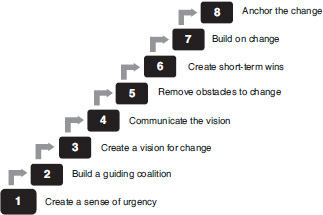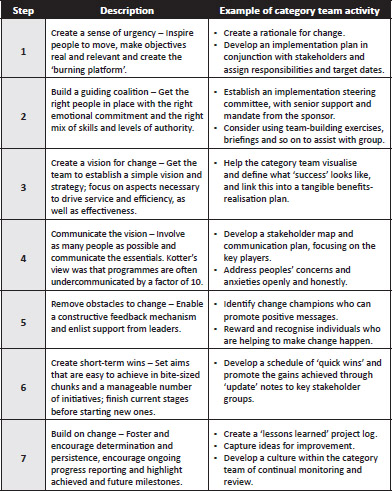Activity 28
Implementing change
Overview
Theories relating to change management are abundant. Authors on the subject regularly refer to the ‘70% failure rate’ associated with the implementation of change programmes, which essentially is what category management is about.
John P. Kotter, a Harvard Business School professor and leading thinker and author on organisational change management, developed his universally acclaimed eight-step change model in the mid-1990s. Each step highlights an important factor to be addressed when undertaking a change project.
Implementation must consider both process and people, in terms of their feelings, attitudes and mindsets. Kotter believes that behaviour is central to a successful change programme.
Elements
Category management teams can face substantial resistance to their plans from a multitude of different stakeholder groups, both internally and externally. In order to implement change successfully in a category, application of the Kotter model can help as illustrated in Figure 5.5.
So what?
Procurement functions are repeatedly criticised by other departments for placing the majority of their attention on upstream activities, such as analysis and sourcing, rather than the subsequent contract management and benefits realisation. This can lead to a ‘malaise’, where procurement benefits are always projected on paper but rarely delivered in practice. Kotter’s framework acts as a helpful reminder of the main factors to think about when involved in the latter stages of the category management process, and when linked to best practice contract management disciplines, they can become a highly effective tool for delivering organisational benefits.
Kotter’s phased model is particularly useful as it considers the representative behaviour of those affected by change at each stage and in turn how best to overcome any resultant resistance. This should aid the category team in relation to key stakeholders, who may not support or want to take on board a new contract/supplier, as ways of managing these individuals; additionally, thinking about how to demonstrate success throughout the implementation can be planned in advance.
Category management application
- Puts stakeholders at the heart of the implementation stage of the category management process
- Provides a practical, phased approach for implementation
- Considers behavioural aspects that can be helpful when working with stakeholders
- Is a useful guide for implementation activities
- Supports the benefits-realisation process
Limitations
This framework does not take into account individual capability and personality, which can have a significant impact upon change programmes. For example, inspiring and encouraging others during implementation may prove difficult for those who do not possess the necessary soft skills.
The eight-step approach also presumes a chronological flow of events. In reality, many of the change activities may be iterative or running in parallel, which means sequencing becomes complex.
The main critique surrounding Kotter’s model is that it is merely a ‘list’, and some academics argue that it is just a part of project management, while others maintain that Kotter places far too much emphasis on changing behavioural attitudes by automatically assuming that there will be resistance regardless.
Template
The following template may be used to support the implementation part of the category management process:
- Template 28: Implementation guide


